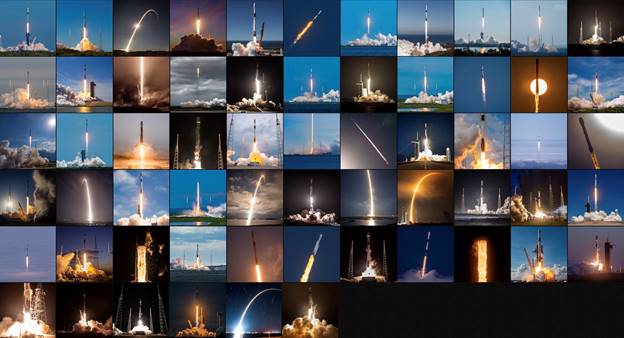Dear Reader,
December 30 capped off a remarkable year for SpaceX. It was the 61st launch for the private aerospace company of the year, a record.
Making the final launch of the year even more special was one of the secrets to SpaceX’s business success – lower cost of payloads to orbit through reusability. It was the 11th mission for the SpaceX Falcon 9 booster used on December 30.
Below is a snapshot of all 61 launches last year:
2022 SpaceX Launches

Source: spaceflightnow.com
And it appears that 2023 will be no less exciting for SpaceX.
The company is kicking off the year with a $750 million raise, lifting its own valuation into orbit – $137 billion. It’s one of the most valuable private companies in history, and third only to two other public aerospace companies: Raytheon ($180 billion) and Boeing ($169 billion).
$137 billion is an extraordinary valuation for a private company. And the $750 million figure is small in comparison to the $3.62 billion that SpaceX raised last summer.
That raises the question: Is an IPO in the works?
An IPO is certainly overdue. After all, SpaceX has been taking in investor’s capital now since its first funding back in 2002.
There are countless numbers of venture capital (VC) firms and angel investors that have provided capital to Musk and his team at SpaceX over the last two decades… I’m sure they’re hungry for some liquidity after the long wait.
Leading this latest round is Andreessen Horowitz, with additional participation from Sequoia and Founders Funds, which are all giants in the VC world.
It’s hard not to be optimistic about SpaceX. There’s no other aerospace company in history like it:
It held a record number of launches in 2022.
It exceeded 1 million subscribers for Starlink – its satellite-based broadband internet service.
It signed up two private commercial spaceflights around the Moon.
It’s on track to support NASA’s Artemis 3, which will send the SpaceX Starship to the Moon around 2025. (And prior to that, it will launch, transport, and insert the Lunar Gateway into the Moon’s orbit.)
And in the weeks ahead, we can expect the inaugural launch of the first Starship into orbit – a great way to kick off the year.
And we shouldn’t forget that SpaceX is literally humanity’s best chance for becoming a multi-planetary species in our lifetimes.
SpaceX is one of the most-anticipated IPOs in history. And there’s a chance for two IPOs.
The first would likely be the spinout of Starlink into its own publicly traded entity. That would be a smart move, as Starlink would raise additional capital from the IPO, much of which would be used to hire SpaceX for additional launch services.
It would be natural for the SpaceX IPO to follow sometime after that. If I had to make a prediction, I would say that Starlink goes public in the second half of this year when market conditions improve, and SpaceX follows in 2024.
We’ve been exploring generative artificial intelligence (AI) quite a bit lately. In fact, just last week, I suggested that this tech will become one of the biggest stories of 2023.
As a reminder, generative AI refers to AI that can produce content, images, and even software code on command. GPT-3, ChatGPT, Stable Diffusion, Google, Meta, Midjourney, and OpenAI’s DALL-E are all great examples.
To give us an idea of just how impressive this technology is, below is an example from Dall-E 2. The written prompt was: “Teddy bears shopping for groceries in the style of ukiyo-e [a form of traditional Japanese artwork].”
AI-Generated Artwork

Source: OpenAI
Again, the AI didn’t find this image somewhere online. It created it based off our prompt.
We’ve talked extensively about the incredible advancements each of these have made. But with bleeding-edge technology like this, sometimes it’s hard to get a feel for what it’s worth from a business perspective.
Well, OpenAI just gave us a rare lens into its inner workings. And the latest information gives us a small glimpse as to how much this kind of AI could be worth.
OpenAI just announced that it expects to generate over $200 million in revenue this fiscal year. From there, the team expects revenue to explode to $1 billion in 2024. That’s a 5 times jump.
One of the ways the organization will generate revenue is by charging users a penny to generate 20,000 words of text and about 2 cents to create a custom image.
That’s incredibly inexpensive. But if we imagine that the AI is utilized millions of times a day, it’s not a stretch to see how OpenAI reaches its revenue goals.
GPT-3, ChatGPT, DALL-E, and the upcoming release of GPT-4 put OpenAI on the fast track to $1 billion-plus in annual revenue. That’s especially remarkable considering the organization has only been around since 2015. And the release of GPT-4 is already one of the most highly anticipated technology events of this year.
As I write this, OpenAI is valued at $20 billion. And I fully expect it to conduct another funding round at some point this year. I think that will push OpenAI’s valuation to $50 billion.
That means OpenAI is one of the most valuable AI companies in history.
And this just strengthens my belief that we’ll see incredible amounts of investment flow into generative AI companies this year. It’s such an explosive area for development, the venture capitalists and private equity firms won’t be able to pass on upcoming investment opportunities.
As for OpenAI, it’s quickly reaching the scale where it can consider a public offering. I doubt that’s something that will happen this year, but 2024 is a distinct possibility. And there’s always the wildcard, which is Microsoft.
Microsoft invested $1 billion back in 2019 in exchange for OpenAI using Microsoft for its cloud computing needs. It has an inside track on OpenAI, and after the incredible developments at OpenAI in 2022, I’m sure that Microsoft would want to own OpenAI outright.
The breakthroughs at OpenAI last year have Google in panic mode right now. And with $107 billion in cash on its balance sheet, Microsoft is one of the few companies that could afford the acquisition.
Stay tuned…
Big news out of a Bleeding Edge favorite: Redwood Materials. The company just announced that it’s building a $3.5 billion electric vehicle (EV) battery recycling campus in South Carolina.
Regular readers may remember Redwood. This is the company founded by Tesla’s former Chief Technology Officer J.B. Straubel.
Redwood’s headquarters is in Nevada. And originally, the company planned to invest more heavily into its facilities there.
This huge investment in South Carolina represents a big shift in corporate strategy. And there’s a very good reason for it…
I don’t think many people know this, but the Southeastern United States is a major hub for auto manufacturing. There are 17 automotive manufacturing plants across North and South Carolina, Tennessee, Georgia, and Alabama.
And BMW has a massive campus in South Carolina to lead its U.S.-based operations. And Toyota is building a new battery plant in North Carolina.
So placing an EV battery recycling center in the region makes perfect sense. It keeps the supply chain tight and efficient.
Keep in mind, Redwood doesn’t produce batteries. It simply recycles used batteries and extracts the salvageable material. Then Redwood sells that material back to battery makers. That’s the business model.
By locating its big campus in South Carolina, Redwood is creating something of a virtuous cycle in the Southeastern U.S. It can recycle batteries and ship the useful materials just up the road where they will go into new battery production.
Some are now calling the region the “Battery Belt” for this reason.
And get this: South Carolina approved $225 million in tax-based incentives for Redwood to build its campus in the state. That makes this the largest economic development project in South Carolina history.
So Redwood Materials is making great strides in its quest to buttress the EV industry with battery recycling services.
Of course, this solves a major environmental problem. EV batteries contain toxic materials that can’t be easily disposed of.
And this also goes a long way toward addressing the key material shortages we’re seeing in the EV battery space as well. In fact, recycling is going to be critical for EV producers to have a shot at hitting even a percentage of their lofty production goals.
So we can think of Redwood Materials as the “back-end” of the EV industry. It may not be flashy. But its services are absolutely critical to the industry’s success.
We’ll wrap up today with an update on the brain-computer interface (BCI) front.
Synchron just announced a $75 million funding round to advance its BCI technology. This values the company at $385 million. Not bad for a company that’s only been around for about six years.
What makes this round especially interesting though is who’s behind it: Bill Gates and Jeff Bezos.
As a reminder, Synchron was the first company to take its BCI tech into a Food and Drug Administration (FDA)-approved clinical trial in the U.S. It beat Elon Musk’s Neuralink to the punch on this.
So it seems we have a race between billionaires forming here. Gates and Bezos are backing Synchron. And Musk is powering Neuralink forward.
And the two companies are taking a decidedly different approach.
Both are focusing the first application on stroke victims, paraplegics, amputees, and patients suffering from neurodegenerative diseases. But Neuralink’s approach requires brain surgery to implant the wireless BCI into the brain.
Meanwhile, Synchron inserts its wireless device through the jugular vein. That makes the procedure somewhat less invasive.
As excited as I am about BCI technology, there’s one aspect I’m keeping an eye on…
The idea of a brain-computer interface has been the stuff of science fiction for years. And, as mentioned, it could be a gamechanger for stroke victims, amputees, and those with neurological disabilities. But there’s also room for abuse.
An implant that allows us to control computing devices with our minds could – in theory – also be used to monitor our own thoughts and emotions.
Are we happy? Sad? Complacent? Or enraged? Could the technology also be used to control how and what we think? In the wrong hands, it could bring mass surveillance and influence directly into our own minds.
This isn’t just a crazy thought, either.
In fact, Klaus Schwab of the World Economic Forum (WEF), and Yuval Harari, one of his top scientific advisors, have publicly talked about their desire to do exactly this using sensors and computing technology.
Harari is quite notorious for referring to those of us in the mass population as “useless people” who are essentially “worthless.” When referring to the importance of COVID, he said:
Covid is critical because this is what convinces people to accept to legitimize total biometric surveillance. We need to not just monitor people, we need to monitor what’s happening under their skin.
I don’t say this to worry us, but only to highlight that this kind of technology can be used for good and for evil.
If we’re aware of its potential, and aware that there are those like many affiliated with the WEF who are planning for something like this, we can hopefully avoid such a frightening application of this technology.
And it’s up to all of us to be vigilant.
Regards,
Jeff Brown
Editor, The Bleeding Edge
The Bleeding Edge is the only free newsletter that delivers daily insights and information from the high-tech world as well as topics and trends relevant to investments.
The Bleeding Edge is the only free newsletter that delivers daily insights and information from the high-tech world as well as topics and trends relevant to investments.